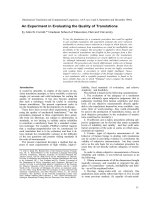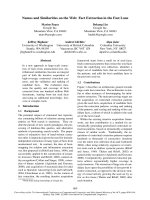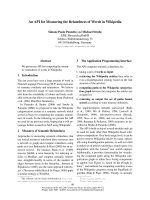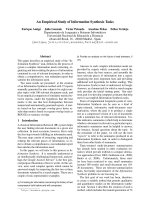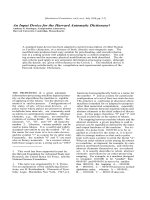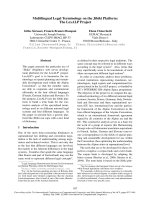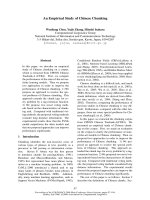Báo cáo khoa học: "An immunohistochemical study on the pancreatic islets cells of the Mongolian gerbils, Meriones unguiculatus" potx
Bạn đang xem bản rút gọn của tài liệu. Xem và tải ngay bản đầy đủ của tài liệu tại đây (2.42 MB, 6 trang )
9HWHULQDU\
6FLHQFH
J. Vet. Sci. (2001), 2(1), 9–14
An immunohistochemical study on the pancreatic islets cells of
the Mongolian gerbils,
Meriones unguiculatus
Sae-kwang Ku, Hyeung-sik Lee*
1
, Ki-dae Park
2
and Jae-hyun Lee
2
Pharmacology & Toxicology Lab., Central Research Laboratories, Dong-Wha Pharm. Ind. Co., Anyang 430-017, Korea
1
Department of Biology, Faculty of Natural Sciences, Kyungsan University, Kyungsan 712-240, Korea
2
Department of Histology, College of Veterinary Medicine, Kyungpook National University, Taegu 702-701, Korea
In order to study the regional distribution and relative
frequency of the immunoreactive endocrine cells in the
pancreatic islets of the Mongolian gerbil, pancreatic sec-
tions of
Meriones unguiculatus
were immunostained using
an immunohistochemical (PAP) method with four types of
specific antisera against insulin, glucagon, somatostatin
and human pancreatic polypeptide (PP). The pancreatic
islets were subdivided into three portions (central region,
mantle zone and peripheral region) according to their
composition of immunoreactive cells. Spherical to spindle
shaped insulin, glucagon, somatostatin and PP-immu-
noreactive cells were observed in this study. Insulin-
immunoreactive cells were present in the central regions
with high frequency, and a few of these cells were also
demonstrated in the mantle zones. Glucagon-immunore-
active cells were mainly restricted to the mantle zones.
However, rare examples were found in the peripheral
regions. As for the glucagon-immunoreactive cells, soma-
tostatin-immunoreactive cells were detected in the mantle
zones and peripheral regions with moderate and rare fre-
quencies, respectively. PP-immunoreactive cells were
found in the mantle zones and peripheral regions with
rare and moderate frequencies, respectively. In the mantle
and the peripheral regions, cytoplasmic process of gluca-
gon-, somatostatin- and PP-immunoreactive cells were
intermingled. In conclusion, the regional distribution of
endocrine cells in the pancreatic islets of Mongolian gerbil
was found to be similar to that of other mammals, espe-
cially other rodents, except for the topographical different
distribution of somatostatin which differs that of other
rodents.
Key words:
Mongolian gerbil, pancreatic islets, endocrine
cell, immunohistochemistry
Introduction
It is generally known that the pancreas of vertebrates is
subdivided into exocrine and endocrine portions. Digestive
enzymes are released in the exocrine and regulatory hor-
mones such as insulin, glucagon, somatostatin and pancre-
atic polypeptide (PP) are produced in the endocrine and
released into blood circulation. The appearance, regional
distribution and relative frequency of these regulatory hor-
mones secreted by endocrine cells in the pancreas are well
recognized by their histochemistry using [17], the immun-
ofluorescence method [23] and immunohistochemistry
[32]. In addition to the above regulatory hormones, peptide
YY-, neuropeptide YY- [1], chromogranin family- [14, 27]
and motilin- [35] immunoreactive cells have also been
demonstrated in the vertebrate pancreas. The pancreas has
been treated as a valuable organ for endocrine study and
the endocrine pancreas has been extensively studied in
association with diabetes [15]. In addition, investigations
of gastroenteropancraetic (GEP) endocrine cells are con-
sidered to be an important part of phylogenetic study [6].
The Mongolian gerbil,
Meriones unguiculatus
, is a
rodent of the family Cricetidae, although it has been
included alternatively among the Muridae. The animal is
an active, nearly ordorless, usually nonaggressive rodent
distinguished by its monogamous mating behavior, water
and temperature conservation mechanisms, spontaneous
epileptiform seizures, relative freedom from spontaneous
disease, and several other unique attributes of interest in
research [11].
Until now, the regional distribution and relative fre-
quency of four major immunoreactive cells, insulin-, glu-
cagon-, somatostatin and PP-, have been reported in the
pancreas of the hamster [3], sand rat (
Psammomys obesus
)
[8], C57BL/6 mouse [10], herbivorous Japanese field vole
(
Microtus montebelli
) [22], guinea pig [25], vole (
Microtus
arvalis
) [28], obese ob+/ob+ mouse [30], preobese and
obese yellow Avy/- mice [33] and wood mouse (
Apodemus
speciosus
) [36]. In addition, angiotensin II-immunoreac-
*Corresponding author
Phone: +82-53-819-1436; Fax: +82-53-819-1558
E-mail:
10 Sae-kwang Ku et al.
tive cells were found in the pancreas of the mouse [20] and
the appearance of calcitonin gene-related peptide- and
cholecystokinin-immunoreactive cells have been reported
in the rat pancreas [7, 29]. With the increasing demand for
diabetic animal models in many fields, the regional distri-
bution and relative frequency of pancreatic endocrine cells,
especially, insulin- and glucagon-producing cells in labora-
tory animals is of interest [9, 10, 33]. It has been accepted
that insulin-immunoreactive cells are located in the central
regions and that the other immunoreactive cells such as
glucagon-, somatostatin- and PP-immunoreactive cells are
located in the peripheral or mantle zones. But, many
researchers have suggested that species-dependent hor-
mone producing cell distributions in the pancreas of differ-
ent species might due to feeding habits, and this is now
generally accepted [34]. In addition, it has also been
reported that different regional distributions and relative
frequencies of endocrine cells in the pancreatic islets were
demonstrated in different portion of the pancreas, which
included the pancreas of single animals [36] and strain-
dependent characteristic distributions of these immunore-
active cells was also detected in connection with attempts
to increase the production of genetically mutated labora-
tory animals, and to increase the breeding rate of laboratory
animals having specific diseases or unique characteristics,
especially in the rat and mouse [9, 10, 30, 33, 36].
Although many studies have concerned the regional dis-
tribution and relative frequency of different endocrine cells
in the pancreas of various vertebrates including several
species and strains of rodents, there have been no reports
on immunohistochemical studies into the endocrine cells
of the pancreatic islets of the Mongolian gerbil, in spite of
their biological, physiological and anatomical differences
from the other rodents. The purpose of the present study
was to clarify the regional distribution and relative fre-
quency of endocrine cells in the pancreatic islets of the
Mongolian gerbil,
Meriones unguiculatus
using an immu-
nohistochemical method (PAP method) and four types of
specific antisera against insulin, glucagon, somatostatin
and PP.
Materials and Methods
Five adult (40~50 g of body weight) Mongolian gerbils,
Meriones unguiculatus
, were acquired from the Asan Insti-
tute for Life Science (Seoul, Korea) and were used in this
study without sexual distinction. After food restriction for
24 hours, the animals were anesthetized with ethyl ether
and then phlebotomized. Samples from the pancreas were
fixed in Bouin's solution, and after paraffin embedding, 3-4
µ
m serial sections were prepared. Representative sections
of each tissue were stained with hematoxylin and eosin for
light microscopic examination of the normal gastrointesti-
nal architecture.
Each representative section was deparaffinized, rehy-
drated and immunostained by the peroxidase anti-peroxi-
dase (PAP) method [31]. Nonspecific reactions were
blocked with normal goat serum prior to incubation with
the specific antisera (Table 1). After rinsing in phosphate
buffered saline (PBS; 0.01 M, pH 7.4), the sections were
incubated in secondary antiserum. They were then washed
in PBS buffer and finally the PAP complex was prepared.
The peroxidase reaction was carried out in a solution of
3,3'-diaminobenzidine tetrahydrochloride, containing
Table 1.
Antisera used in this study
Antisera raised* Code Source Diluton
Insulin PUO290395 BioGenex Lab., San Ramon. 1 : 20
Glucagon PUO390598 BioGenex Lab., San Ramon. 1 : 20
Somatostatin PUO421295 BioGenex Lab., San Ramon. 1 : 20
PP
1)
PUO660495 BioGenex Lab., San Ramon. 1 : 20
*All antisera were raised in rabbits except for insulin, which was raised in rabbits.
1)
PP: human pancreatic polypeptide
Table 2.
Regional distributions and relative frequencies of the endocrine cells in the pancreatic islets of the Mongolian gerbil,
Meriones
unguiculatus
Immunoreactive cells
Pancreatic islets
Central region Mantle zone Peripheral region
Insulin +++ + -
Glucagon - +++ ±
Somatostatin - ++ ±
PP
1)
-±++
* Relative frequencies; +++: numerous, ++: moderate, +: a few, ±: rare, -: not detected
1)
PP: human pancreatic polypeptide.
Endocrine cells in the pancreatic islets of the Mongolian gerbil 11
0.01% H
2
O
2
in Tris-HCl buffer (0.05M, pH 7.6). After
immunostaining, the sections were lightly counterstained
with Mayer's hematoxylin and immunoreactive cells were
observed under a light microscope.
The specificity of each immunohistochemical reaction
was determined as recommended by Sternberger [31],
including the replacement of specific antiserum by the
same antiserum, which had been preincubated with its cor-
responding antigen. The relative frequency of occurrence
of each type of immunoreactive cell was allocated to one
of five categories according to its frequency, as observed
by light microscopy.
Results
In this study, all four kinds of the immunoreactive endo-
crine cells were detected using antisera against insulin,
glucagon, somatostatin and PP in the pancreatic islets,
which were distinguished as three distinct layers, a central
region, a mantle zone and a peripheral region with their
composition of immunoreactive cells. Different regional
distributions and relative frequencies of these immunore-
active cells were observed in the different pancreatic
regions, and these differences are shown in Table 2. Spher-
ical to spindle or occasionally oval to round-shaped immu-
noreactive cells were observed in the pancreatic islets of
the Mongolian gerbil.
Insulin-immunoreactive cells
Spherical to spindle shaped insulin-immunoreactive
cells were located in the central pancreatic islet region with
numerous frequency and rarely round to oval shaped cells
of variable size were also observed. In addition, a few fre-
quencied cells were also observed in the mantle zone inter-
mingled with other immunoreactive cells, especially
glucagon- and somatostatin-immunoreactive cells. How-
ever, no insulin-immunoreactive cells were found in the
peripheral regions, which predominantly contained PP-
immunoreactive cells (Fig. 1a, b).
Glucagon-immunoreactive cells
Spherical to spindle shaped glucagon-immunoreactive
cells were located in the mantle and peripheral regions of
the pancreatic islets with numerous and rare frequencies,
respectively, regardless of size. Occasionally, rare round to
ovally shaped cells were also observed in these regions. In
the mantle and peripheral regions, the cytoplasmic pro-
cesses of glucagon-immunoreactive cells were intermin-
gled with other immunoreactive cells especially
Fig. 1. Insulin-immunoreactive cells in the pancreatic islets o
f
Mongolian gerbils. Note that most of the immunoreactive cells
were located in the central regions of pancreatic islets regardless
of size. a, b: ×240. PAP method.
Fig. 2. Glucagon-immunoreactive cells in the pancreatic islets o
f
Mongolian gerbils. Note that most of the immunoreactive cells
were located in the mantle zones of pancreatic islets regardless o
f
size. a, b: ×240. PAP method.
12 Sae-kwang Ku et al.
somatostatin- and PP-immunoreactive cells. However, no
glucagon-immunoreactive cells were observed in the cen-
tral regions, where numerous insulin-immunoreactive cells
were found (Fig. 2a, b).
Somatostatin-immunoreactive cells
Spherical to spindle shaped somatostatin-immunoreac-
tive cells were found in the mantle and peripheral regions
of the pancreatic islets with moderate and rare frequencies,
respectively, regardless of size. Occasionally, rare round to
ovally shaped cells were also observed in these regions. In
the mantle and peripheral regions, the cytoplasmic pro-
cesses of these immunoreactive cells were intermingled
with other immunoreactive cells, especially glucagon- and
PP-immunoreactive cells. However, no somatostatin-
immunoreactive cells were observed in the central regions
where numerous insulin-immunoreactive cells were found
(Fig. 3a).
PP-immunoreactive cells
Spherical to spindle shaped somatostatin-immunoreac-
tive cells were observed in the mantle and peripheral
regions of the pancreatic islets with rare and moderate fre-
quencies, respectively, regardless of their size. Occasion-
ally, rare round to ovally shaped cells were also found in
these regions. In the mantle and peripheral regions, the
cytoplasmic processes of PP-immunoreactive cells were
intermingled with other immunoreactive cells, especially
glucagon- and somatostatin-immunoreactive cells. How-
ever, no PP-immunoreactive cells were demonstrated in
the central regions, where numerous insulin-immunoreac-
tive cells were found (Fig. 3a).
Discussion
Unlike other rodents, Mongolian gerbils of both sexes
have a distinct midventral abdominal pad composed of
large sebaceous glands under the control of gonadal hor-
mones [4], and Mongolian gerbil has unique feeding habits
[11]. In addition, the male gerbils have higher packed red-
cell volumes (PCV), hemoglobin levels, total leukocyte
counts, and circulating lymphocyte counts than the
females, and some erythrocytes of both sexes show a
prominent polychromasia and basophilic stippling [11]. In
spite of their biological, physiological and anatomical dif-
ferences from other rodents, no immunohistochemical
studies are available on the pancreatic endocrine cells in
the pancreatic islets of the Mongolian gerbil. In the present
study, the four major types of endocrine cells, insulin-, glu-
cagon-, somatostatin- and PP-immunoreactive cells that
are generally found in the mammalian pancreas, were
detected in the pancreatic islets.
Insulin is synthesized in the B cells of the pancreatic
islets and regulates the serum glucose levels [13]. In mam-
mals, the regional distribution and relative frequency of
insulin-immunoreactive cells in the pancreas have been
reported in the hamster [3], three-toed sloth (
Bradypus var-
iegates
) [5], C57BL/6 mouse [10], opossum [18], Austra-
lian brush-tailed possum [19], voles [28], various
laboratory animals [34] and wood mouse [36]. From these
reports, it is known that insulin-immunoreactive cells are
situated in the central regions of the mammalian pancreas
and that other cells, such as, glucagon-, somatostatin- and
PP-immunoreactive cells, surrounded them. However,
somewhat contradicting the finding of other researchers,
Reddy et al. [26] reported that these-immunoreactive cells
are observed in the majority of islets where they occur
peripherally as groups of cells, and within the pancreatic
islets of several marsupial species. In the present study,
most of the insulin-immunoreactive cells were restricted to
the central regions of islets in the Mongolian gerbil, which
is similar to previous reports on rodents [3, 10, 28, 33, 34,
36].
Glucagon is synthesized in the A cells of the pancreas
and regulates blood glucose levels [13]. Morphologically
similar cells are also present in the digestive tract of the
Fig. 3.
Somatostatin (a)- and human pancreatic polypeptide (b)-
immunoreactive cells in the pancreatic islets of Mongolian
gerbils. Note that most of the somatostatin-immunoreactive cells
were located in the mantle zones of pancreatic islets regardless o
f
size while human pancreatic polypeptide-immunoreactive cells
were observed in the outermost peripheral regions of pancreatic
islets. a, b:
×
240. PAP method.
Endocrine cells in the pancreatic islets of the Mongolian gerbil 13
dog. In the present study, glucagon-immunoreactive cells
were found in the mantle and the peripheral regions of pan-
creatic islets. Although glucagon-immunoreactive cells
have been found in the mantle and peripheral regions of
mammalian pancreatic islets [3, 5, 10, 18, 19, 28, 33, 34,
36] including the present study, species-dependent varia-
tions have been reported in the equine pancreas, in which
A-cells, demonstrated by anti-glucagon, were found in the
center of pancreatic islets [12]. In addition, it has also been
reported that under specific disease conditions, such as,
those in the obese (diabetic condition) mouse, glucagon-
immunoreactive cells are intermingled with insulin-immu-
noreactive cells in the central regions of the pancreatic
islets. In contrast, normal non-obese littermates showed a
peripheral localization of these immunoreactive cells [30].
Somatostatin, which consists of 14 amino acids, was
isolated initially from the hypothalamus of sheep. It was
found to be present in straight and cyclic forms [2]. This
substance inhibits the secretion of gastrin, cholecystokinin,
secretin, glucagon, insulin, motilin and gastric acid [16]
and the absorption of amino acids, glucose and fatty acids
in the gastrointestinal tract [2]. To date, somatostatin-
immunoreactive cells have been found in the outermost
regions of mammalian pancreatic islets [3, 5, 10, 18, 19,
28, 33, 34, 36]. However, in the present study, most of
these immunoreactive cells were found in the mantle
zones, mixed with glucagon-immunoreactive cells; PP-
immunoreactive cells were found to occupy the outermost
regions of pancreatic islets in this study. These topographi-
cally different distributional patterns in mammalian spe-
cies [3, 5, 10, 18, 19, 28, 33, 34, 36] are considered as
species-dependent variations, and intra-species topograph-
ical variations are considered as reflections of unique dis-
eases and suggests that under specific disease conditions,
such as obesity (diabetic condition) mouse, somatostatin-
immunoreactive cells show different distributional patterns
[30].
PP is a peptide hormone, which contains 36 amino
acids, and is synthesized by F cells in the pancreatic islets
[13]. The specific function of this peptide is not clear, how-
ever, it has been postulated that it is related to food intake
inhibition [13] and Polak et al [24] reported that it pro-
moted the secretion of gastric acid and stimulated the glyc-
olysis of liver in avian species. It has been reported that
PP-immunoreactive cells are conspicuously distributed in
the peripheral regions of the pancreatic islets in mamma-
lian species [3, 10, 18, 19, 28, 33, 34, 36]. In addition, the
colocalization of these immunoreactive cells with seroto-
nin-immunoreactive cells has been demonstrated in the
pancreatic islets of the opossum [18] and cattle [21] though
da Mota et al. [5] reported that PP-immunoreactive cells
were not found in the pancreas of the three-toed sloth. In
the present study, which is in agreement with previous
studies [3, 10, 18, 19, 28, 33, 34, 36], PP-immunoreactive
cells were detected in the outermost regions of the pancre-
atic islets, although rarely cells were intermingled with
other immunoreactive cells in the mantle zone, where glu-
cagon-immunoreactive cells predominated, followed by
somatostatin-immunoreactive cells.
In conclusion, the regional distribution of endocrine
cells in the pancreatic islets of Mongolian gerbil was found
to be similar to that of other mammals, especially rodents,
except for the topographically different distribution of
somatostatin compared to that of other rodents. Cell core
in the pancreatic islets of Mongolian gerbils were com-
posed of centrally located insulin-immunoreactive cells
and glucagon- and somatostatin-immunoreactive cells
located in the mantle zone, PP-immunoreactive cells sur-
rounded immunoreactive cells located in the mantle zone
at the peripheral regions of pancreatic islets.
References
1. Alli-Rachedi, A., Varndell, I. M., Adrian, T. E., Gapp, D.
A., van Noorden, S., Bloom, S. R. and Polak, J. M. Pep-
tide YY (PYY) immunoreactivity is co-stored with gluca-
gon-related immunoreactants in endocrine cells of the gut
and pancreas. Histochemistry 1984, 80(5), 487-491.
2. Brazeau, P., Vale, W., Burgurs, R., Ling, N., Butcher, M.,
Rivier, J. and Guillermin, R. Hypothalamic polypeptide
that inhibits the secretion of immunoreactive pituitary
growth hormone. Science 1973, 179(68), 77-79.
3. Camihort, G., Del Zotto, H., Gomez Dumm, C. L. and
Gagliardino, J. J. Quantitative ultrastructural changes
induced by sucrose administration in the pancreatic B cells
of normal hamsters. Biocell 2000, 24(1), 31-37.
4. Cheal, M. Life span environmental influences on species
typical behavior of
Meriones unguiculatus
. Basic Life Sci.
1987, 42, 145-159.
5. da Mota, D. L., Yamada, J., Gerge, L. L. and Pinheiro, P.
B. An immunohistochemical study on the pancreatic endo-
crine cells of the three-toed sloth,
Bradypus variegatus
.
Arch. Histol. Cytol. 1992, 55(2), 203-209.
6. D’Este, L., Buffa, R., Pelagi, M., Siccardi, A. G. and
Renda, T. Immunohistochemical localization of chromogra-
nin A and B in the endocrine cells of the alimentary tract of
the green frog,
Rana esculanta
. Cell Tissue Res. 1994,
277(2), 341-349.
7. Ding, W. G., Guo, L. D., Kitasato, H., Fujimura, M. and
Kimura, H. Phylogenic study of calcitonin gene-related
peptide-immunoreactive structures in the pancreas. His-
tochem. Cell Biol. 1998, 109(2), 103-109.
8. Donev, S., Petkov, P., Marquie, G., Duhault, J. and
Jablenska, R. Immunohistochemical investigations of the
endocrine pancreas in normoglycemic sand rat (
Psammomys
obesus
). Acta. Diabetol. Lat. 1989, 26(4), 309-313.
9. Fu, Q., Honda, M., Ohgawara, H., Igarashi, N., Toyada,
C., Omori, Y. and Kobayashi, M. Morphological analysis
of pancreatic endocrine cells in newborn animals delivered
by experimental diabetic rats. Diabetes Res. Clin. Pract.
14 Sae-kwang Ku et al.
1996,
31(1-3)
, 57-62.
10.
Gomez Dumm, C. L., Console, G. M., Lunna, G. C.,
Dardenne, M. and Goya, R. G.
Quantitative immunohis-
tochemical changes in the endocrine pancreas of nonobese
diabetic (NOD) mice. Pancreas 1995,
11(4)
, 396-401.
11.
Harkness, J. E. and Wagner, J. E.
The biology and medi-
cine of rabbits and rodents, pp. 50-57 4th ed. Wiliams &
Wilkins, Baltimore, 1995.
12.
Helmstaedter, V., Feurle, G. E. and Forssmann, W. G.
Insulin-, glucagon- and somatostatin-immunoreactive cells
in the equine pancreas. Cell Tissue Res. 1976,
172(4)
, 447-
454.
13.
Hsu, W. H. and Crump, M. H.
The endocrine pancreas. In:
McDonald, L. E. and Pineda, M. H. (ed), Veterinary endocri-
nology and reproduction, pp 186-201, Lea & Febiger, Phila-
delphia, 1989.
14.
Ito, H., Hashimoto, Y., Kitagawa, H., Kon, Y. and Kudo,
N.
Distribution of chromogranin containing cells in the por-
cine gastroenteropancreatic endocrine system. Jpn. J. Vet.
Sci. 1987,
50
, 395-404.
15.
Jansson, L. and Sandler, S.
The influence of cyclosporin A
on the vascular permeability of the pancreatic islets and on
diabetes induced by multiple low dose of streptozotocin in
the mouse. Virchows Archiv A Pathol. Anat. Histopathol.
1988,
412(3)
, 225-230.
16.
Kitamura, N., Yamada, J., Calingasan, N. Y. and
Yamashita, T.
Immunocytochemical distribution of endo-
crine cells in the gastrointestinal tract of the horse. Equine
Vet. J. 1984,
16(2)
, 103-107.
17.
Kobayashi, K. and Ali, S. S.
Cell types of the endocrine
pancreas in the shark,
Scylliorhinus stellaris
as revealed by
correlative light and electron microscopy. Cell Tissue Res.
1981,
215(3)
, 475-490.
18.
Krause, W. J., Cutts, J. H. 3rd, Cutts, J. H. and Yamada,
J.
Immunohistochemical study of the developing endocrine
pancreas of the opossum (
Didelphis virginiana
). Acta. Anat.
(Basel). 1989,
135(1)
, 84-96.
19.
Leigh, C. M. and Edwin, N. A.
Light-microscopic immu-
nocytochemical study of the endocrine pancreas in the Aus-
tralian brush-tailed possum (
Trichosurus vulpecula
). Eur. J.
Histochem. 1992,
36(2)
, 237-241.
20.
Leung, P. S., Chan, H. C. and Wong, P. Y.
Immunohis-
tochemical localization of angiotensin II in the mouse pan-
creas. Histochem. J. 1998,
30(1)
, 21-25.
21.
Nakajima, S., Kitamura, N., Yamada, J., Yamashita, T.
and Watanabe, T.
Immunohistochemical study on the endo-
crine pancreas of cattle with special reference to coexistence
of serotonin and glucagon or bovine pancreatic polypeptide.
Acta. Anat. (Basel).
131(3)
, 235-240.
22.
Ohara, N., Kitamura, N., Yamada, J. and Yamashita, T.
Immunohistochemical study of gastroenteropancreatic endo-
crine cells of the herbivorous Japanese field vole,
Microtus
montebelli
. Res. Vet. Sci. 1986,
41(1)
, 21-27.
23.
Orci, L.
Macro- and micro-domains in the endocrine pan-
creas. Diabetes 1982,
31(8 pt 1)
, 538-564.
24.
Polak, J. M., Adrian, T. E., Bryant, M. G., Bloom, S. R.,
Heitz, P. H. and Pearse, A. G. E.
Pancreatic polypeptide in
the insulomas, gastrinomas and glucagonomas. Lancet 1979,
55
, 328-330.
25.
Reddy, S. N., Bibby, N. J. and Elliott, R. B.
Cellular distri-
bution of insulin, glucagon, pancreatic polypeptide hormone
and somatostatin in the fetal and adult pancreas of the guinea
pig: a comparative immunohistochemical study. Eur. J. Cell
Biol. 1985,
38(2)
, 301-305.
26.
Reddy, S., Bibby, N. J., Fisher, S. L. and Elliott, R. B.
Immunolocalization of insulin, glucagon, pancreatic
polypeptide and somatostatin in the pancreatic islets of the
possum,
Trichosurus vulpecula
. Gen. Comp. Endocrinol.
1986,
64(1)
, 157-162.
27.
Rindi, G., Buffa, R., Sessa, F., Tortora, O. and Solcia, E.
Chromogranin A, B and C immunoreactivities of mamma-
lian endocrine cells: Distribution from costored hormones/
prohormones and relationship with argyrophil component of
secretory granules. Histochemistry 1986,
85(1)
, 19-28.
28.
Sasaki, M., Arai, T., Usui, T. and Oki, Y.
Immunohis-
tochemical, ultrastructural, and hormonal studies on the
endocrine pancreas of voles (
Microtus arvalis
) with monoso-
dium aspartate-induced diabetes. Vet. Pathol. 1991,
28(6)
,
497-505.
29.
Shimizu, K., Kato, Y., Shiratori, K., Ding, Y., Song, Y.,
Furlantto, R., Chang, T. M., Watanabe, S., Hayashi, N.,
Kobayashi, M. and Chey. W. Y.
Evidence for existence of
CCK-producing cells in rat pancreatic islets. Endocrinology
1998,
139(1)
, 389-396.
30.
Starich, G. H., Zafirova, M., Jabelenska, R., Petkov, P.
and Lardinois, C. K.
A morphological and immunohis-
tochemical investigation of endocrine pancreas from obese
ob+/ob+ mice. Acta. Histochem. 1991,
90(1)
, 93-101.
31.
Sternberger, L. A.
The unlabeled antibody peroxidase-anti-
peroxidase (PAP) method. In: Sternberger, L. A. (ed), Immu-
nocytochemistry, pp. 104-169, John Wiley & Sons, New
York, 1979.
32.
Sternberger, L. A., Hardy, P. H., Cuculis, J. J. and Meyer,
H. G.
The unlabeled antibody enzyme method of immuno-
cytochemistry: Preparation and properties of soluble anti-
gen-antibody complex (horseradish peroxidase-
antihorseradish peroxidase) and use in identification of spi-
rochetes. J. Histochem. Cytochem. 1970,
18(5)
, 315-333.
33.
Warbritton, A., Gill, A. M., Yen, T. T., Bucci, T. and
Wolff, G. L.
Pancreatic islet cells in preobese yellow Avy/-
mice: relation to adult hyperinsulinemia and obesity. Proc.
Soc. Exp. Biol. Med. 1994,
206(2)
, 145-151.
34.
Wieczorek, G., Pospischil, A. and Perentes, E. A.
Com-
parative immunohistochemical study of pancreatic islets in
laboratory animals (rats, dogs, minipigs, nonhuman pri-
mates). Exp. Toxicol. Pathol. 1998,
50(3)
, 151-172.
35.
Yamada, J., Campos, V. J. M., Kitamura, N., Pacheco, A.
C., Yamashita, T. and Yanaihara, N.
An immunohis-
tochemical study of endocrine cells in the pancreas of
Caiman latirostris
(Alligatorinae), with special reference to
pancreatic motilin cells. Biomed. Res. 1986,
7
, 199-208.
36.
Yukawa, M., Takeuchi, T., Watanabe, T. and Kitamura, S.
Proportions of various endocrine cells in the pancreatic islets
of wood mice (
Apodemus speciosus
). Anat. Histol. Embryol.
1999,
28(1)
, 13-16.



